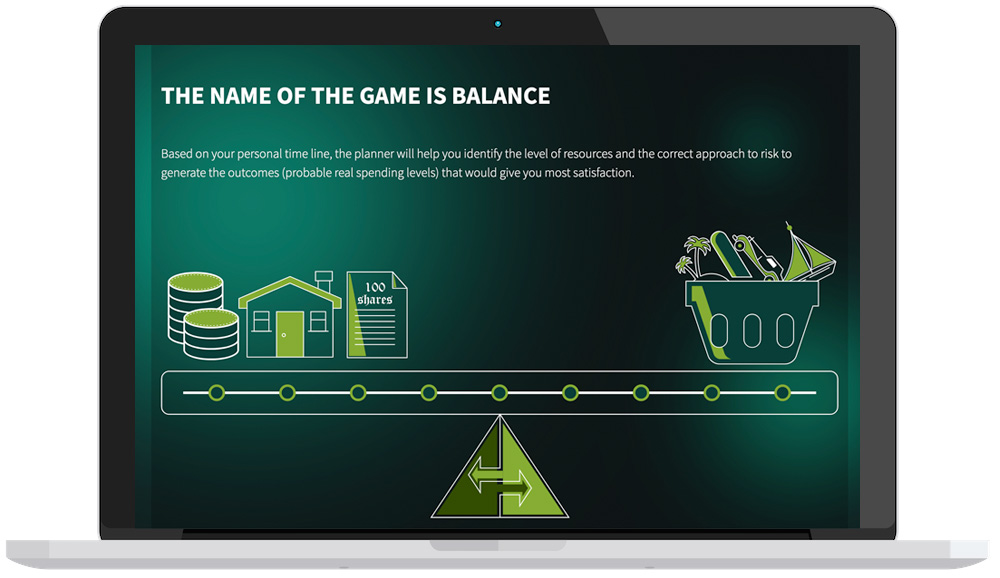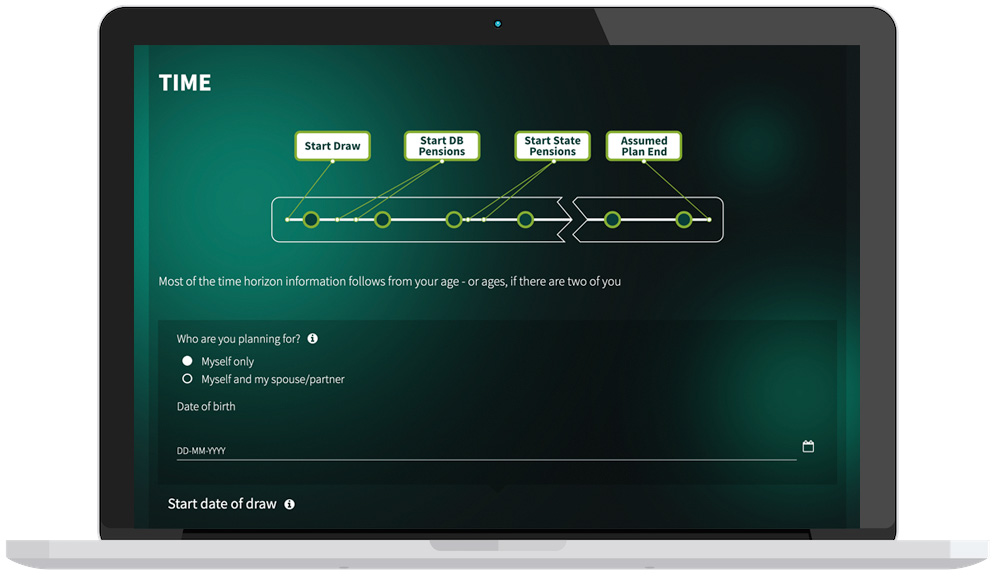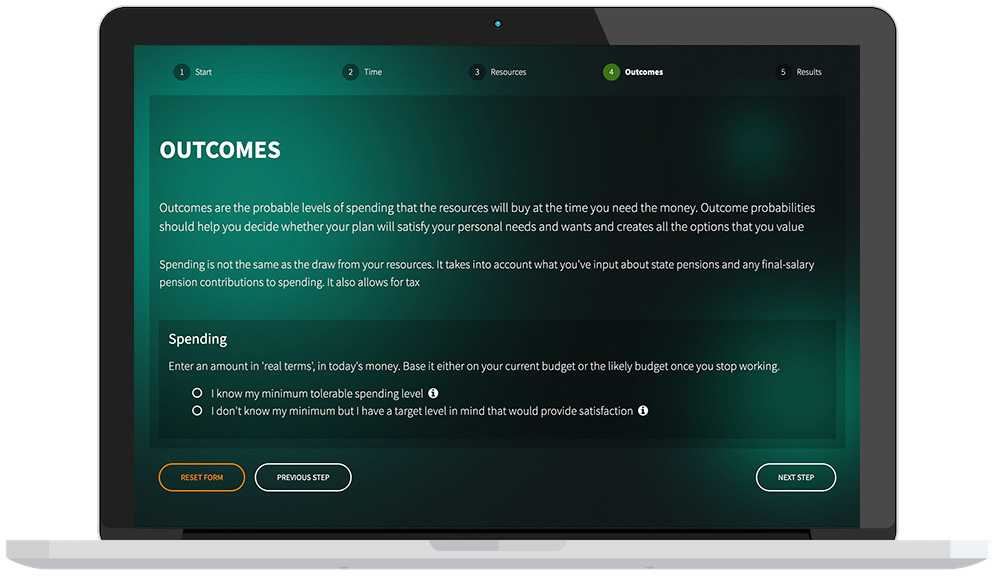Find the best possible balance of resources, time, risk and spending outcomes.
The best possible plan is the one that maximises the benefits you visualise your money providing and is realistically achievable with the resources available and the risk you are willing and able to take.


SAVING FOR RETIREMENT
Everything you need to prepare your ideal retirement
Find out how much you need to save to achieve the retirement outcomes you need and want. This will be based on an investment strategy designed and managed uniquely to deliver your planned outcomes.
ABOUT TO RETIRE
Prepare your wealth for the “draw down phase” of life
Are you confident you know how much you can safely spend at every stage? The Planner will help you craft a drawdown plan that makes best use of all available resources.


ABOUT TO RETIRE
Prepare your wealth for the “draw down phase” of life
Are you confident you know how much you can safely spend at every stage? The Planner will help you craft a drawdown plan that makes best use of all available resources.

ALREADY WITHDRAWING SAVINGS
Could your current retirement strategy be improved on?
Perhaps you are spending too little, or too much. Are you taking too much or too little risk? How much would cost savings improve my outcomes? The Planner provides the answers you need to improve your drawdown plan.
The Planner is designed to find the best possible balance of resources, time, risk and spending outcomes.
- What the planner will do
- Planner VS Calculator
- Model drawdown answers
- Guidance from an adviser
- Pension drawdown
- Drawdown FAQs
Plan your own savings and spending goals
It’s a holistic plan because it focuses on total spending from all resources, of which draw from pension accounts may only be a part. Draw sits on top of any guaranteed income, like State Pension and Defined Benefit pensions, and alongside ISAs and other non-pension accounts.
![]()
Calculate savings
Calculate required savings when you know your spending needs.
![]()
Calculate spending
Calculate spending outcomes when you know the available resources.
![]()
Balancing risk
Show you how the answers vary with the approach you take to risk.
![]()
Changing timeline
Or if you alter the planned dates on your personal timeline.
Sophistication is what makes it a planner, not a calculator
A probabilistic, quantitative model aims to capture the true uncertainty about market returns and future inflation and the consequences of each for the sustainability of spending. That sophistication is what makes it a planner, not a calculator.
A calculator, by contrast, relies on simplifying assumptions with no room for uncertainty:
- Markets earn a standardised annual rate of return, or somebody’s best guess
- Inflation is about the same as it has been recently, or somebody’s guess
- Both follow smooth, linear paths without deviations
- You withdraw money at the same rate every year
- You die on time, with the average longevity for someone your age now
That’s like answering the question ‘what if everything is average?’ But your life hasn’t been average to date and won’t be from now on either. The 50:50 outcome is a toss of the coin and a coin toss isn’t a plan.
Answering the questions that matter to you
Planning with a model is about answering the questions that matter to you and need maximum possible precision:
- What’s the impact of much better or worse markets and inflation over the rest of my life?
- How long will my capital last depending on those outturns?
- And supposing I live a very long time?
- What’s the chance I will have to cut back on my spending? And by how much?
- Supposing I want to spend more money early in retirement?
- What if I need expensive care late in life?
- How will my gross income be taxed and how can I manage the tax rate efficiently?
- When can I safely gift?
- When can I stop working?
Explore your saving and spending options further
The free-to-use Planner here is designed for your ease of control of the variables. It uses intuitive sliders. You can choose from some stored profiles for spending. Tax is only approximated based on your inputs. The client version, shared between the client and their adviser, is more elaborate, allowing for more granular changes in variables to design the best possible plan.
But even with this free version you can ask to speak to an adviser at any time for help using the Planner. Or to discuss how our services might be appropriate for you.
Your time spent inputting data will not go to waste if you contact us, as you will then be able to upload the data so we can have a better-informed conversation.
Pension advice and the pension drawdown framework
Though our Drawdown Planner integrates all sources of income and capital, our wealth management service includes advising on the best use of pension accounts within the plan, based on the tax treatment of ‘pension drawdown’.
Draw from pension accounts will normally use the ‘Flexi Access Drawdown’ (FAD) option but much will depend upon how you choose to deal with tax free cash (Pension Commencement Lump Sum or PCLS). The strategy may use the Uncrystallised Funds Pension Lump Sum (UFPLS) option.
Read about our pension advice and the pension drawdown framework here.
Drawdown FAQs
Find out more about pension drawdown by reading some of our FAQs below.
- What is a safe withdrawal rate?
- How should I use the flexibility drawdown offers?
- Why are drawdown calculators limited to pension products?
- What should I expect to pay for drawdown?
- What kind of pension fund is best for drawdown?
- What are the best-performing drawdown funds?
- Should I consolidate my pensions?
- Is drawdown for life?
What the planner will do
Plan your own savings and spending goals
It’s a holistic plan because it focuses on total spending from all resources, of which draw from pension accounts may only be a part. Draw sits on top of any guaranteed income, like State Pension and Defined Benefit pensions, and alongside ISAs and other non-pension accounts.
Calculate savings
Calculate required savings when you know your spending needs.
Calculate spending
Calculate spending outcomes when you know the available resources.
Balancing risk
Show you how the answers vary with the approach you take to risk.
Changing timeline
Or if you alter the planned dates on your personal timeline.
Planner VS Calculator
Sophistication is what makes it a planner, not a calculator
A probabilistic, quantitative model aims to capture the true uncertainty about market returns and future inflation and the consequences of each for the sustainability of spending. That sophistication is what makes it a planner, not a calculator.
A calculator, by contrast, relies on simplifying assumptions with no room for uncertainty:
- Markets earn a standardised annual rate of return, or somebody’s best guess
- Inflation is about the same as it has been recently, or somebody’s guess
- Both follow smooth, linear paths without deviations
- You withdraw money at the same rate every year
- You die on time, with the average longevity for someone your age now
That’s like answering the question ‘what if everything is average?’ But your life hasn’t been average to date and won’t be from now on either. The 50:50 outcome is a toss of the coin and a coin toss isn’t a plan.
Model drawdown answers
Answering the questions that matter to you
Planning with a model is about answering the questions that matter to you and need maximum possible precision:
- What’s the impact of much better or worse markets and inflation over the rest of my life?
- How long will my capital last depending on those outturns?
- And supposing I live a very long time?
- What’s the chance I will have to cut back on my spending? And by how much?
- Supposing I want to spend more money early in retirement?
- What if I need expensive care late in life?
- How will my gross income be taxed and how can I manage the tax rate efficiently?
- When can I safely gift?
- When can I stop working?
Guidance from an adviser
Explore your saving and spending options further
The free-to-use Planner here is designed for your ease of control of the variables. It uses intuitive sliders. You can choose from some stored profiles for spending. Tax is only approximated based on your inputs. The client version, shared between the client and their adviser, is more elaborate, allowing for more granular changes in variables to design the best possible plan.
But even with this free version you can ask to speak to an adviser at any time for help using the Planner. Or to discuss how our services might be appropriate for you.
Your time spent inputting data will not go to waste if you contact us, as you will then be able to upload the data so we can have a better-informed conversation.
Pension drawdown
Pension advice and the pension drawdown framework
Though our Drawdown Planner integrates all sources of income and capital, our wealth management service includes advising on the best use of pension accounts within the plan, based on the tax treatment of ‘pension drawdown’.
Draw from pension accounts will normally use the ‘Flexi Access Drawdown’ (FAD) option but much will depend upon how you choose to deal with tax free cash (Pension Commencement Lump Sum or PCLS). The strategy may use the Uncrystallised Funds Pension Lump Sum (UFPLS) option.
Read about our pension advice and the pension drawdown framework here.
Drawdown FAQs
Drawdown FAQs
Find out more about pension drawdown by reading some of our FAQs below.
- What is a safe withdrawal rate?
- How should I use the flexibility drawdown offers?
- Why are drawdown calculators limited to pension products?
- What should I expect to pay for drawdown?
- What kind of pension fund is best for drawdown?
- What are the best-performing drawdown funds?
- Should I consolidate my pensions?
- Is drawdown for life?
Frequently Asked Questions
What is a safe withdrawal rate?
This is a critical question the nearer you get to the start of draw. Only sophisticated modelling can answer it reliably. It depends on how confident you need to be about sustaining spending in real terms year to year, and any time preferences, such as spending more earlier, less later. It depends crucially on how long the plan has to last, itself depending on the consequences of running short or running out. Those would be very different if, for instance, you had nothing else to fall back on and little capacity to adjust spending.
But the answer also depends on how you invest. Sustainability (both avoiding cuts and not running out) is a function of risk. Too much and you may run out if markets are unfriendly. Too little and you may not be able to spend at a rate you see as satisfactory. The Planner provides quantified answers specific to your personal timeline and the investment approach. You will use those answers to determine how much risk you want to take as well as how much to spend.
How should I use the flexibility drawdown offers?
Drawing down from a pension account gives you flexibility about when to start (as long as it’s not before age 55), how much to draw and when, and how to manage the draw between taxable income and tax free cash. But if your pension drawdown is part of a retirement plan including non-pension capital, you will apply the pension draw flexibility to managing both time preferences and your effective tax rate. This may include deferring pension draw to minimise taxes on death.
Flexibility brings choices and choices may call for advice. Advice costs money but it may come bundled with investment management costs you can anyway justify. When spending has to be funded out of your own resources, it is one of the most important management tasks you will face in life. Without management costs, can you be sure it will get the management it deserves?
Why are drawdown calculators limited to pension products?
If the only resources you had set aside to fund your retirement were in pension accounts, this would make sense. But it doesn’t describe everyone. Many have other savings in ISAs or taxable investment accounts or indeed non-financial assets that could contribute at some stage to spending. Not to mention State Pensions or final-salary pensions. Our Drawdown Planner is unusual in being holistic, not limited to pension accounts.
Nor is it even limited to retirement goals. Other drawdown goals include divorce and injury settlements or any investment goal where taking either income or capital from the portfolio is subject to sustainability requirements, such as a charitable endowment or life interest trust.
What should I expect to pay for drawdown?
Drawing down from a personal pension product usually attracts flat-rate charges from the pension provider in addition to the underlying investment charges levied by the investment managers. For most, the biggest cost is likely to be the advice fee but generally this advice fee is asset based and does not change when you move from the accumulation phase to the drawdown phase. Advice costs vary widely between firms, even for the same size of portfolio. You can see some survey data here, with our costs for comparison.
What kind of pension fund is best for drawdown?
Many but not all pension accounts offer drawdown. Not all workplace schemes currently support drawdown. This means auto-enrolment default funds can be appropriate for people during the savings phase but transfer to a different type of fund may be sensible at retirement.
This could be a Defined Contribution pension plan from, for instance, a life insurance company, or a Self-invested Personal Pension (SIPP) from a range of providers. If financial advice and portfolio management is being offered in conjunction with pension accounts to hold some of the underlying investments, a SIPP is likely to be preferred, due to the greater flexibility and the scope to reduce costs. The total cost is not necessarily a function of type. Some low-cost SIPPs are cheaper than auto-enrolment schemes.
It is likely that in time drawdown options will be more widely available, as will support for the choices that flexibility provides. Support could be integrated in the product, whatever the type, or take the form of standalone tools with the same modelling sophistication as ours. This is too big a task and too big a market not to see product development.
What are the best-performing drawdown funds?
Drawdown is a process not a product. The same products can be used for both the saving and withdrawal stages. The investment strategy may change because of the stage but the performance of the strategy will still depend on the underlying market exposures and their returns and, to a lesser extent, how good (or lucky) the investment manager. Charges will also affect performance but independently of the portfolio being used for drawdown.
Past performance (unlike charges) is not predictive of future performance so it is of no more value in a drawdown context than in any other context.
Should I consolidate my pensions?
If you have collected different Defined Contribution pensions from various employers over your working life, there are two good reasons for transferring them into a single scheme (be it one of the existing ones or a new one): lowering costs and increasing control.
Scheme costs vary and older ones in particular may carry high charges. If you care about the overall investment strategy, it will be easier to see it and control it if the money is in one place. Information about your pension, including projected outcomes, will then be simpler and clearer and paperwork minimised. It will certainly simplify drawdown, and transfer will anyway be necessary if any of your old plans does not support it.
Be sure you know before transferring any old plans whether they have any special benefits attached that you ought not to give up. Depending on the sums involved, that may warrant paying for independent advice, rather than relying on a company offering a pension consolidation service whose terms and conditions may limit their liability for checking.
Is drawdown for life?
No. You always have the option to use your remaining drawdown funds to buy an annuity. In fact, drawdown is best thought of as a process of deferring an annuity, possibly indefinitely. For many people, an annuity becomes a compelling choice in the later stages of retirement with some or all of the remaining fund, as there is limited scope then to take risk. Earlier in retirement, investment risk and inflation risk are more important for real spending outcomes than longevity risk. But in later years, longevity risk, as in the possibility of outliving your capital, tends to dominate other risk sources.
 “No-one can be enjoying what’s happening in the markets and it would be wrong to be complacent but knowing that the portfolio has been tested to include such scenarios, and is structured to deliver our drawdown requirement for several years regardless, has given us a level of comfort which we realised we had almost been taking for granted. I don’t think we would have felt as in control a few years ago so thanks for that.”
“No-one can be enjoying what’s happening in the markets and it would be wrong to be complacent but knowing that the portfolio has been tested to include such scenarios, and is structured to deliver our drawdown requirement for several years regardless, has given us a level of comfort which we realised we had almost been taking for granted. I don’t think we would have felt as in control a few years ago so thanks for that.”